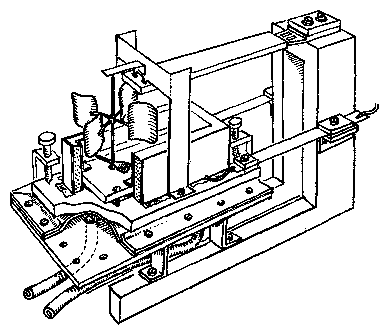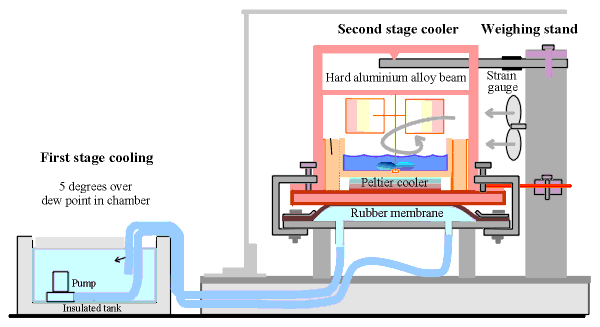
 |
An experimental chamber for generating a water vapour flux |
This chamber contains a reservoir with a known quantity of water. Water can be evaporated into the chamber air or condensed from the chamber air at a defined rate. Once the water vapour is in the air it distributes itself between the air and the experimental material. The resulting relative humidity is calculated from the measured dew point and ambient temperature.
The heart of the control system is a weighed reservoir of water whose temperature can be controlled between about zero and 40 degrees. Water will condense or evaporate according to the water temperature in relation to the dew point of the air. It may come as a surprise that a water surface is capable of condensing water but if it is cold enough that is what happens!

This is a perspective, cut away view of the controller. It is about 300 mm long and is capable of condensing about 2 g/hr of water, depending on the relative humidity.
The next picture shows how it functions.

The first cooling stage generates a stream of water at five degrees above the dew point temperature of the air in the chamber. This means that no dew will condense on the pipes within the chamber. This water cools the hot side of a second stage cooler working on the Peltier principle.
A Peltier device uses the heat generated, or absorbed, when current passes through the junction between two semiconductors. It is not very efficient, because the heat flows back through the semiconductors and some ordinary resistance heating also reduces the efficiency. The Peltier cooler is used to cool the water reservoir below the dew point of the chamber air. Water will condense onto the water in the reservoir and, in small amounts, on the outside of the reservoir. This unwanted condensation does not matter because the whole assembly of Peltier device, reservoir and insulation is weighed.
Just before the reservoir is to be weighed the first stage water pump is stopped so that the rubber membrane collapses clear of the heat sink of the Peltier cooler. The entire assembly painted pink and orange on the diagram now puts all its weight on the weighing beam. The heat sink is massive enough to absorb the heat generated during the time needed for weighing.
Electricity is brought to the device through two stainless steel flat springs (shown in red on the diagram), which do not disturb the weighing process.
The fan driven stirrer is necessary to move the cold water up from the surface of the cooler. A vigorous air movement is also necessary for a good rate of absorption.
This device will condense water from air down to about 30%RH. If it needs to operate at a lower RH the water can be replaced by a solution of sugar, glycerol or a hygroscopic salt.
Evaporation is achieved by easing up on the cooling or by reversing the voltage to the Peltier device, which is actually better at warming than at cooling.

This work is licensed under a Creative Commons Attribution-Noncommercial-No Derivative Works 3.0 License.